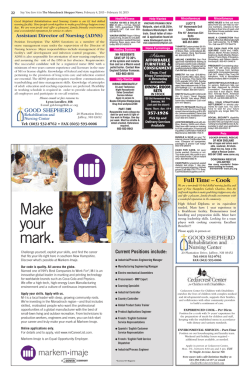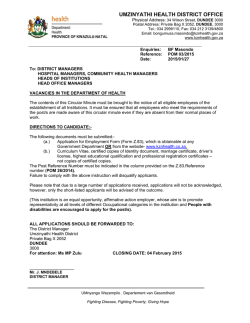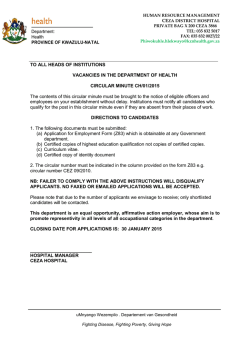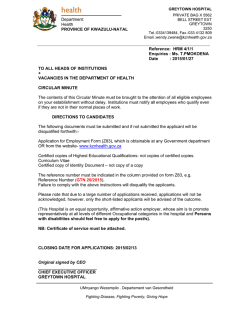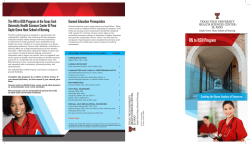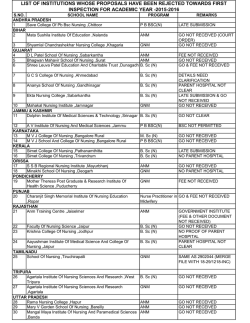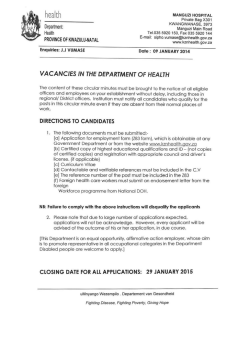
Barbados
CONTRIBUTION OF NURSING IN THE REGION OF THE AMERICAS AND ITS POTENTIAL towards Universal Access to Health and Universal Health Coverage BARBADOS Wendy Sealy Chief Nursing Officer, Ministry of Health Barbados CONTRIBUTION OF NURSING IN THE REGION OF THE AMERICAS AND ITS POTENTIAL TOWARD UNIVERSAL ACCESS TO HEALTH AND UNIVERSAL HEALTH COVERAGE. CONTRIBUTION OF NURSING AND ITS POTENTIAL IN BARBADOS By Dr. Wendy Sealy, Chief Nursing Officer OBJECTIVES OF THE PRESENTATION Present a country overview of Barbados Outline the Epidemiological profile and current situational analysis Explain the context of Health sector reform Describe the Nursing human resources Outline the challenges related to nursing human resources List the services offered Explain the contribution of nurses to Universal Health Outline the challenges related to Universal Health Outline the Next steps Barbados: A country review Barbados a sovereign island country in the Lesser Antilles. It is 34 kms (21 mi) in length and up to 23 kms (14 mi) in width, covering an area of 432 square kms (167 sq mi). It is situated in the western area of the North Atlantic and 100 kms (62 mi) east of the Windward Islands and the Caribbean Sea. It is the most easterly of the Caribbean islands. Epidemiological profile Barbados is an independent democratic country in the Caribbean with a mid-year population estimated at 275,000 in 2007 occupying 166 square miles; One of the most densely populated countries in the world. In 2008 total life expectancy at birth was 77.5 years, with female life expectancy reaching 80.0 and male life expectancy reaching 74.9. Infant mortality rate declined steadily from 14 per 1,000 live births in the period 1990 to 1995 to 11 per 1,000 in the period 2000 to 2005 In 2006, total fertility rate was 1.5 births per woman. A significant epidemiological trend in Barbados is the increasing prevalence of overweight, obesity, and chronic non-communicable diseases in the general population. BARBADOS: CURRENT SITUATIONAL ANALYSIS Universal Health-High priority of the overall national development agenda Several policy measures introduced to improve the living conditions of the population: Health care free at the point of delivery-funded through general taxation Health expenditure approximately 4% of GDP Comprehensive health services provided through primary, secondary and tertiary care systems (public and private). Comprehensive Expanded Programme of Immunization (EPI). CURRENT SITUATIONAL ANALYSIS cont’d Access to quality sexual and reproductive health services; reproductive rights Access to contraceptives and safe termination of pregnancy Early detection and prevention of cervical cancer Reduction in the number of deaths related to cervical cancer Introduction of the Human Papilloma Virus (HPV) vaccine in January, 2014 Maternal death rate 0.8 per thousand. CURRENT SITUATIONAL ANALYSIS cont’d Comprehensive STI/HIV programme- evidence informed, gender-sensitive, and human rights-based Declines in HIV-related morbidity and mortality and in mother-to-child trans mission 1. Expansion of HIV prevention and care services through decentralized testing and referral 2. Coverage of ARVs is currently 86% for those who need it 3. A reduction of AIDS mortality rates to under 2% 4. A reduction of mother- to- child transmission of HIV to 0.8% 2003-2012 Health care reform (HCR) HCR impacted by the following: 1. Multi-year budget cycle 2. Accrual accounting system (replaced cash accounting system) 3. Information systems policy 4. Human resource performance management system Health sector reform cont’d Based on the Barbados Strategic Plan for Health 2000-2012 Emphasis on the priorities focused on the Caribbean Cooperation for Health Initiative Strengthened primary, secondary and tertiary care systems Mental health reform programmes Enhanced surveillance systems Phased implementation of a health information system. Nursing human resources Development of a draft Nurses Human Resources Strategy 2013-2018 Distribution- concentrated in the public health sector Training- pre-service training at tertiary level/ post graduate training education available Labour market-dynamic with a focus on labour market analysis Practice- general clinical and specialized services Challenges related to nursing human resources Human resource management systems Finance systems Administrative and management systems Services General clinical Specialty clinics Maternal and Child care Health education and health promotion Disease surveillance Care of the Elderly Training Community services Auxiliary services General management and administration CONTRIBUTION OF NURSES TO Universal Health Policy, Leadership and management Collaborative partnerships Education and Training Clinical practice Research CHALLENGES related to Universal Health Limited fiscal space and constrained financing Increased reliance of population on government operated health services Dynamic health care needs of population Static health care models Aging human resource base Lack of a comprehensive nursing research agenda NEXT STEPS Assessment of gaps in achieving Universal Health from a nursing perspective utilizing the strategic priorities. Conduct an evaluation of the nursing structure within the country context. Establish national nursing research agenda- priorities of Universal Health. Increase nurse participation in policy processes at all levels. Increase the involvement of nurses in the health finance debate. Build on the achievements and successes of nurses in programmes and activities which increase Universal Health. Review the findings of the national consultation on Universal Health (2014) with a view of operationalizing the recommendations. Strengthen partnerships between and among state and non-state actors. Strengthened coordination of the Universal Health utilizing tenets of Health Systems Strengthening and the WHO Building Blocks. THANK YOU Thank you for YOUR PARTICIPATION paho.org/nursing observatoriorh.org/enfermeria facebook.com/EnfAmericas The recording will be available at: http://observatoriorh.org/enfermeria twitter.com/EnfAmericas
© Copyright 2025
